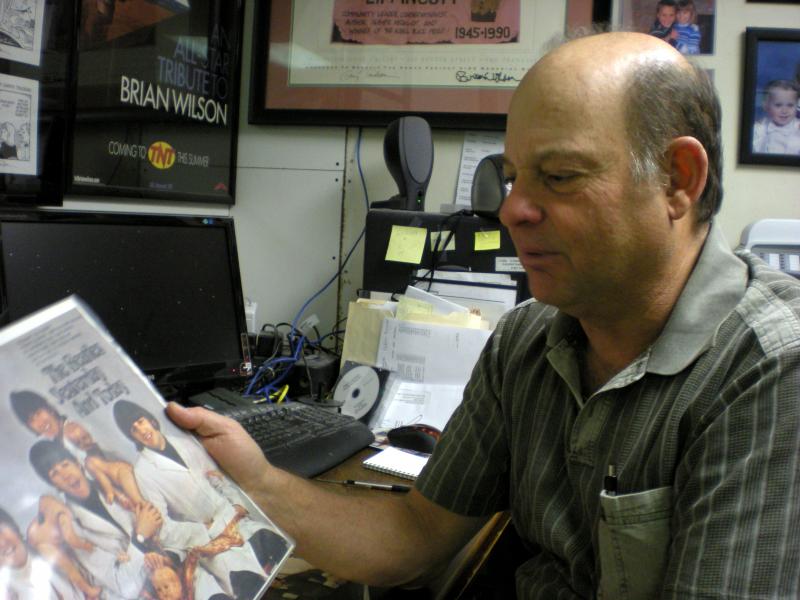Rockaway Records Rolls On Through Recession
Wayne Johnson works in an office filled with rarities and has a computer database full of sales of items that would only be recognized by people with esoteric knowledge of music and the recording industry. The wall is covered by posters, a couple of which are signed by Brian Wilson, the visionary behind the Beach Boys. On his desk lies a book of lyrics by the gravelly voiced singer Tom Waits. Wayne is using the book to identify the titles of the original hand-written Waits lyrics he keeps in a ziplock bag – yet one more set of items in the collection.

The troubles facing independent record stores over the past several years are twofold. Music retail sales are down across the board, with digital music taking a growing percentage. Add the effect of the recession on small businesses, and it becomes clear that staying in business will not be easy for anyone. Johnson and his brother Gary, co-owners of Rockaway Records in Silver Lake, have survived by staying true to their niche: insanely rare collectibles. They recently sold a 1964 David Bowie (who still went as “Davy Jones” at the time) rare English print for $25,000.
They started at swap meets in the parking lot of a Capitol Records store, where people were selling used records and collectibles. Now, Rockaway Records is one of the few independent record shops weather the recession. Johnson spoke to Neon Tommy about how they’ve done it.
Neon Tommy: How did your business take off?
Wayne Johnson: What we started doing was advertising in Goldmine magazine, which was kind of the Bible for record collectors. We did our first ad in there listing a lot of picture discs and promotional records, and once the ad went in there the phone literally started ringing off the hook. We were getting calls from Germany and England, because the market was even bigger overseas. So records that people were only getting $10 or $20 for at the Capitol swap meet, we were selling for $50. So that’s what got me thinking, “Hey, this could be a pretty good business.”
NT: When did you move into this building?
WJ: When this building was for sale in 1992, it was an old nightclub, and we ended up buying it, and that was about 9,000 square ft. And by the time we moved in here, things started changing. We were growing, we moved, and tripled our size. Then business started to go down, and it turned out I didn’t really need all that space, so I started leasing out part of the building. At first, I wanted to be like Amoeba, but I’ll be honest with you – bigger is not better. Our main thing is, we’re collectors.
NT: How did you adjust to the double whammy of digital music and the recession?
WJ: You just change with the times. The reason most businesses fail is they don’t follow what’s going on and they don’t adjust. The market is shrinking for CDs, no question about that. But on the other hand, we’ve got a great niche market for vinyl. I think our vinyl sales actually surpassed our CD sales for the first time in like 20 years, because we’ve got a niche market.
And we don’t put out junk. Sometimes I have to buy the junk to get the good stuff. A few years ago we bought a collection of 100,000 LPs, and probably 50,000 of them I wouldn’t put them in our store.
NT: It seems like vinyl might be a more stable market, too.
WJ: It seems like it. We’re still selling a lot of CDs, but the prices are going down. The average price of a CD in our store now is about three dollars. And it makes sense – if you ever look at Amazon, you can buy CDs for a penny.
NT: How do you determine pricing? Is there a guide for it?
WJ: There is, but it doesn’t mean a whole lot. It’s based on two things: rarity and demand. You could have the rarest record in the world by Perry Como, and you might get five bucks for it. Or you might have the rarest record in the world by the Beatles and name your price. We’ve been doing it so long, so we’ve seen just about everything. Like the Beatles’ “butcher cover.” We probably sell 50 to 100 of them a year. And these sell in the $800-1,000 range. People think they’re rare, but they’re not. It doesn’t really have too much rarity, but it has incredible demand.
NT: Do you feel confident enough to expand in any way?
WJ: Not really expanding. I don’t want another location or anything. But I am looking for bigger and better collections. I know a lot of people in the music industry that are, you know, getting up there in age, and some of them have a house-full of records worth a million dollars.
NT: It seems like knowledge is an essential part of making the business work.
WJ: No doubt. Between my brother, my manager and myself, we’ve got more knowledge than anyone else. My brother, especially. It’s minute differences. I can show you two Beatles records, one from 1964, and one from 10 months earlier, and one will be $10 and the other will be $2,000. It’s the little things that mean everything.



